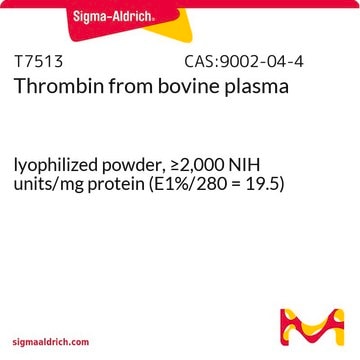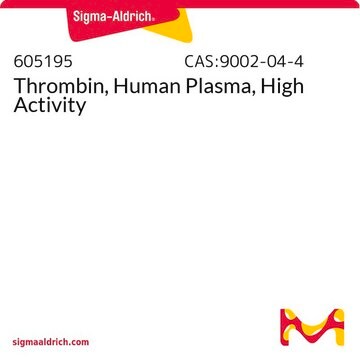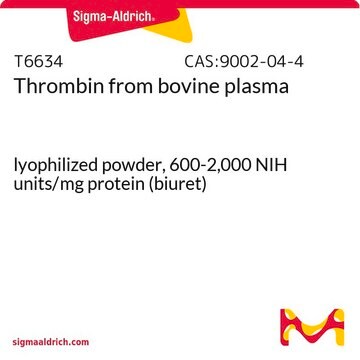T4393
Thrombine from human plasma
lyophilized powder, 1500-3500 NIH units/mg protein (E1%/280, 18.3), suitable for cell culture
Synonyme(s) :
Facteur IIa
About This Item
Produits recommandés
Source biologique
human plasma
Niveau de qualité
Stérilité
sterile
Forme
lyophilized powder
Activité spécifique
1500-3500 NIH units/mg protein (E1%/280, 18.3)
Technique(s)
cell culture | mammalian: suitable
Impuretés
HIV, hepatitis B and hepatitis C, tested negative
Numéro d'accès UniProt
Température de stockage
−20°C
Informations sur le gène
human ... F2(2147)
Vous recherchez des produits similaires ? Visite Guide de comparaison des produits
Description générale
Application
- as a medium supplement for the pre-treatment of endothelial cell culture prior to confocal microscopy and enzyme linked immunosorbent assay (ELISA)
- in the gelatinization of mesenchymal stem cells (MSCs) for preparing fibrin–MSC construct
- for screening serine protease inhibitor, OGTI from frog skin secretion
Actions biochimiques/physiologiques
Définition de l'unité
Reconstitution
Remarque sur l'analyse
Clause de non-responsabilité
Inhibiteur
Mention d'avertissement
Danger
Mentions de danger
Conseils de prudence
Classification des risques
Resp. Sens. 1
Code de la classe de stockage
10 - Combustible liquids
Classe de danger pour l'eau (WGK)
WGK 3
Point d'éclair (°F)
Not applicable
Point d'éclair (°C)
Not applicable
Certificats d'analyse (COA)
Recherchez un Certificats d'analyse (COA) en saisissant le numéro de lot du produit. Les numéros de lot figurent sur l'étiquette du produit après les mots "Lot" ou "Batch".
Déjà en possession de ce produit ?
Retrouvez la documentation relative aux produits que vous avez récemment achetés dans la Bibliothèque de documents.
Les clients ont également consulté
Articles
Thrombin Factor IIa is an endolytic serine protease that selectively cleaves the Arg--Gly bonds of fibrinogen to form fibrin and release fibrinopeptides A and B.
Thrombin Factor IIa is an endolytic serine protease that selectively cleaves the Arg--Gly bonds of fibrinogen to form fibrin and release fibrinopeptides A and B.
Thrombin Factor IIa is an endolytic serine protease that selectively cleaves the Arg--Gly bonds of fibrinogen to form fibrin and release fibrinopeptides A and B.
Thrombin Factor IIa is an endolytic serine protease that selectively cleaves the Arg--Gly bonds of fibrinogen to form fibrin and release fibrinopeptides A and B.
Notre équipe de scientifiques dispose d'une expérience dans tous les secteurs de la recherche, notamment en sciences de la vie, science des matériaux, synthèse chimique, chromatographie, analyse et dans de nombreux autres domaines..
Contacter notre Service technique











